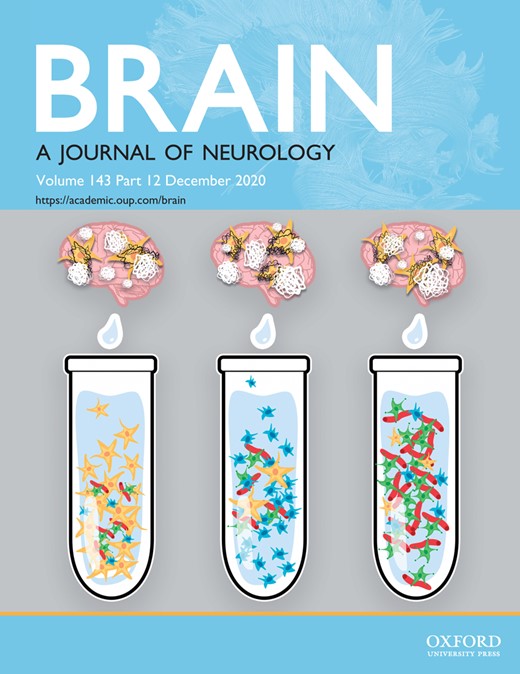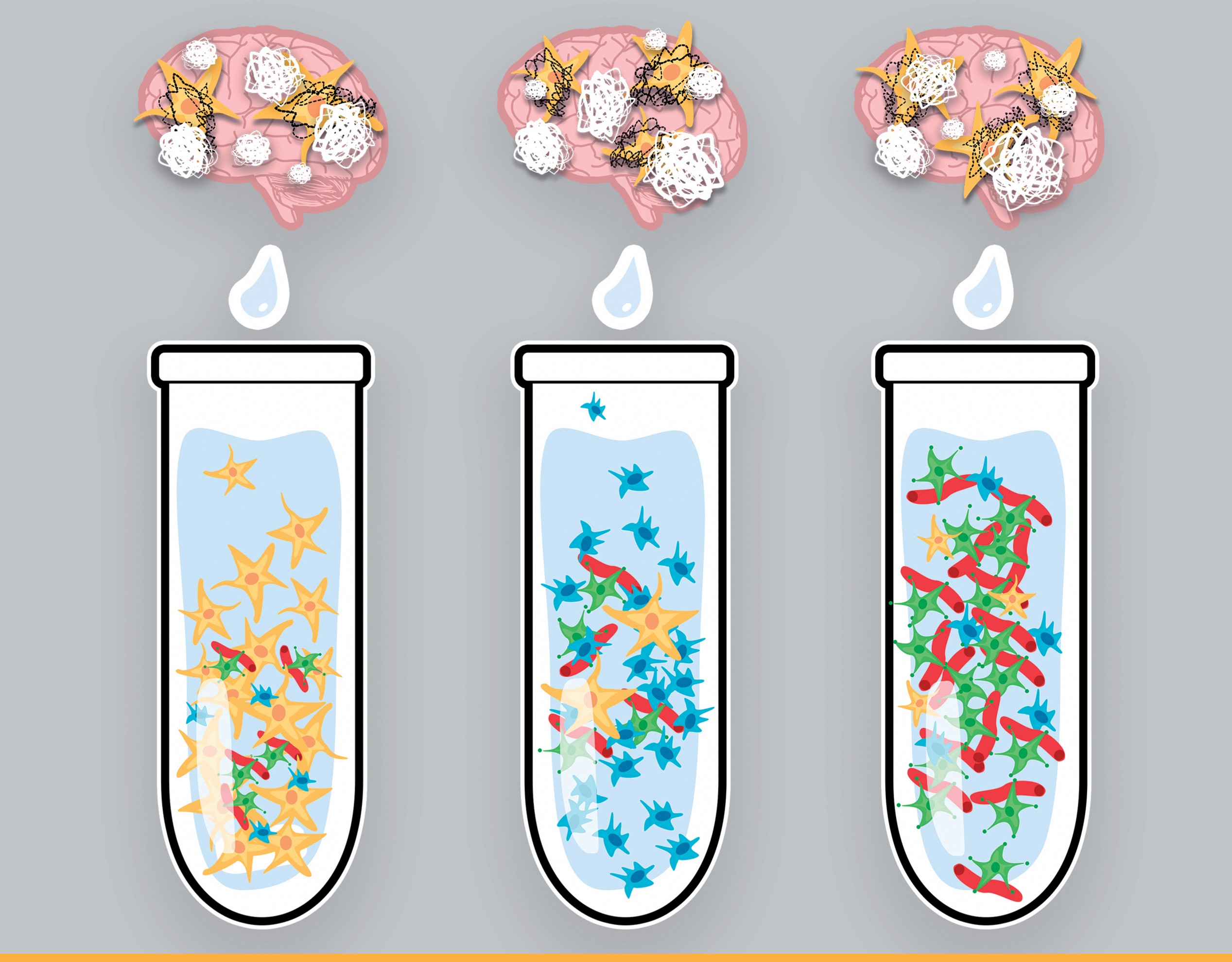
Cover image

Volume 143, Issue 12, December 2020
Editorial
Editorial
Scientific Commentaries
Unresponsive or just asleep? Do local slow waves in the perilesional cortex have a function?
This scientific commentary refers to ‘Local sleep-like cortical reactivity in the awake brain after focal injury’, by Sarasso et al. (doi:10.1093/brain/awaa338).
Increased O-GlcNAcylation prevents degeneration of dopamine neurons
This scientific commentary refers to ‘O-GlcNAcylation regulates dopamine neuron function, survival and degeneration in Parkinson disease’, by Lee et al. (doi:10.1093/brain/awaa320).
Neglected cytotoxic T cell invasion of the brain: how specific for Parkinson’s disease?
This scientific commentary refers to ‘CD8 T cell nigral infiltration precedes synucleinopathy in early stages of Parkinson’s disease’, by Galiano-Landeira et al. (doi:10.1093/brain/awaa269).
Serum neurofilament light chain uncovers neurodegeneration early in the course of Alzheimer’s disease
This scientific commentary refers to ‘Stage-specific links between plasma neurofilament light and imaging biomarkers of Alzheimer’s disease’, by Benedet et al. (doi:10.1093/brain/awaa342).
Situated minds: conceptual and emotional blending in neurodegeneration and beyond
This scientific commentary refers to ‘When affect overlaps with concept: emotion recognition in semantic variant of primary progressive aphasia’, by Bertoux et al. (doi:10.1093/brain/awaa313).
Review Articles
The microglial component of amyotrophic lateral sclerosis
Clarke and Patani review the involvement of microglia in ALS, focusing specifically on evidence for spatiotemporally regulated neurotoxic and neuroprotective roles. Understanding how microglia contribute to the ‘cellular phase’ of ALS promises to advance the development of therapies with a mechanistic rationale.
The expanding genetic landscape of hereditary motor neuropathies
Beijer and Baets review the current genetic landscape of hereditary motor neuropathies, highlighting recent reports of novel genes/mutations and discoveries related to disease mechanisms. They then link hereditary motor neuropathies to related disorders by examining the involvement of common disease pathways.
Report
Variants in the SK2 channel gene (KCNN2) lead to dominant neurodevelopmental movement disorders
Mochel et al. describe a dominant channelopathy resulting from pathogenic variants in KCNN2, encoding the SK2 channel. This disorder is characterized by developmental delay and intellectual disability, frequently associated with early-onset movement disorders manifesting as cerebellar ataxia or extrapyramidal symptoms.
Clinical Trial
Beneficial effects of autologous mesenchymal stem cell transplantation in active progressive multiple sclerosis
In a randomised phase 2 controlled trial in patients with progressive multiple sclerosis, Petrou et al. show that mesenchymal stem cell (MSC) transplantation is well-tolerated and reduces the risk of disease progression compared to sham injection. Intrathecal MSC administration was superior to intravenous.
Original Articles
Natural history of Charcot-Marie-Tooth disease type 2A: a large international multicentre study
Pipis et al. describe the characteristics and longitudinal follow-up of 225 patients with Charcot-Marie-Tooth disease type 2A, caused by mutations in MFN2. They describe how different mutations affect disease onset and rate of progression and identify sensitive clinical assessments that can be used for disease monitoring.
Magnetic resonance spectroscopy reveals mitochondrial dysfunction in amyotrophic lateral sclerosis
Sassani et al. use phosphorous-31 MRS to examine energy metabolism in individuals living with ALS (motor neuron disease). They detect clinically relevant alterations in metabolites in brainstem and in skeletal muscle, with implications for therapeutic research targeting mitochondrial dysfunction.
Trigeminal neurovascular contact in SUNCT and SUNA: a cross-sectional magnetic resonance study
Lambru et al. argue that trigeminal neurovascular contact with morphological changes is involved in the aetiology of both SUNCT and SUNA. The absence of any significant radiological differences between SUNCT and SUNA adds to evidence suggesting they should be considered a single clinical entity.
Brain cancer induces systemic immunosuppression through release of non-steroid soluble mediators
Systemic immunosuppression is a hallmark of glioblastoma and other neurological insults including stroke and TBI. Ayasoufi et al. show that brain cancers and brain injuries suppress immunity through release of non-steroidal soluble factors that disrupt immune homeostasis and dampen responses of the peripheral immune system.
Evolution of neuroinflammation across the lifespan of individuals with Down syndrome
Most individuals with Down syndrome develop Alzheimer’s pathology early in life. In a cross-sectional post-mortem study, Flores-Aguilar et al. study neuroinflammation across the lifespan in Down syndrome and reveal profound changes in microglial activation and brain cytokine expression along the Alzheimer’s continuum.
Local sleep-like cortical reactivity in the awake brain after focal injury
See Krone and Vyazovskiy (doi:10.1093/brain/awaa396) for a scientific commentary on this article.
Using TMS and EEG in awake patients with focal cortical injuries, Sarasso et al. reveal the presence of sleep-like dynamics in perilesional areas, coexisting with typical wakefulness cortical reactivity in control areas. Reversing perilesional sleep-like dynamics could represent a novel strategy for rehabilitation.
Diffuse axonal injury predicts neurodegeneration after moderate–severe traumatic brain injury
Graham et al. show that diffuse axonal injury in the chronic phase after a single moderate-severe traumatic brain injury (TBI) strongly predicts progressive white matter atrophy. This suggests that acute injury triggers neurodegeneration and may explain the elevated rates of Alzheimer's disease and CTE after TBI.
O-GlcNAcylation regulates dopamine neuron function, survival and degeneration in Parkinson disease
See Hart and Huang (doi:10.1093/brain/awaa398) for a scientific commentary on this article.
Lee et al. show that O-GlcNAcylation, an evolutionarily conserved post-translational modification, is critical for the physiological functioning and survival of dopaminergic neurons. Upregulating O-GlcNAcylation mitigates neurodegeneration, synaptic impairments and motor deficits in a mouse model of Parkinson’s disease.
CD8 T cell nigral infiltration precedes synucleinopathy in early stages of Parkinson’s disease
See Halliday (doi:10.1093/brain/awaa390) for a scientific commentary on this article.
Galiano-Landeira et al. provide evidence that CD8 T cell cytotoxic attack initiates and propagates neuronal death and synucleinopathy in Parkinson’s disease. They demonstrate that nigral CD8 T cell infiltration precedes synucleinopathy in presymptomatic individuals, and that CD8 T cell density correlates with neuronal death.
Inhibitory control dysfunction in parkinsonian impulse control disorders
By tracking spectral and dynamic signatures of inhibitory mechanisms at the EEG source level, Meyer et al. report that impulse control disorders in Parkinson’s disease are not only associated with dysfunctions in value- or reward-based responding, but also involve dysfunctions in circuits controlling motor execution.
Brain network remodelling reflects tau-related pathology prior to memory deficits in Thy-Tau22 mice
Degiorgis et al. use structural and functional MRI, plus behavioural and histological analysis, to investigate early connectome signatures of tauopathy in the Thy-Tau22 mouse model of Alzheimer’s disease. The results reveal modified resting state connectivity in memory networks prior to the onset of memory impairment.
Recalibrating the epigenetic clock: implications for assessing biological age in the human cortex
Existing DNA methylation clocks are highly accurate in blood but are less precise when used in older samples or on brain tissue. Shireby et al. develop a novel epigenetic clock that performs optimally in human cortical tissue and has the potential to identify phenotypes associated with biological ageing in the brain.
Pathophysiological subtypes of Alzheimer’s disease based on cerebrospinal fluid proteomics
Using CSF proteomics, Tijms et al. identify three Alzheimer’s disease subtypes that show: 1) hyperplasticity and increased BACE1 levels; 2) innate immune activation; and 3) blood-brain barrier dysfunction with low BACE1 levels. Future therapeutics may need tailoring to individual disease subtypes.
Stage-specific links between plasma neurofilament light and imaging biomarkers of Alzheimer’s disease
See Brier and Day (doi:10.1093/brain/awaa370) for a scientific commentary on this article.
Neurofilament light (NfL) is a marker of neuroaxonal injury. Benedet et al. report that plasma NfL levels differentially associate with amyloid and tau pathologies across the Alzheimer’s disease continuum, and are associated with distinct patterns of longitudinal grey and white matter volume loss.
The accumulation rate of tau aggregates is higher in females and younger amyloid-positive subjects
In a longitudinal PET study, Smith et al. show that tau accumulation rates are higher in females, younger Aβ-positive individuals, and those with higher baseline tau load. This is in contrast to Aβ-accumulation rates, which are higher in APOE-ε4 carriers and older individuals.
BACE inhibition causes rapid, regional, and non-progressive volume reduction in Alzheimer’s disease brain
In the phase 3 EPOCH trial, use of the BACE inhibitor verubecestat was associated with a reduction in MRI hippocampal volume relative to placebo after 78 weeks. Sur et al. present the results of further analyses exploring this effect, and show that verubecestat produced non-progressive volume losses in amyloid-rich regions.
Somatic TARDBP variants as a cause of semantic dementia
Could somatic variants arising during brain development give rise to non-hereditary neurodegenerative disease? By sequencing DNA from brain tissue and blood from the same semantic dementia patients, van Rooij et al. identify brain-specific somatic TARDBP variants with pathogenicity supported by functional assays.
Neuropsychiatric symptoms in limbic-predominant age-related TDP-43 encephalopathy and Alzheimer’s disease
LATE neuropathological change (LATE-NC) is associated with a dementia syndrome that clinically overlaps with Alzheimer’s disease. Liu et al. show that the combination of LATE-NC and Alzheimer’s disease is not associated with greater neuropsychiatric symptom burden than either pathology alone.
When affect overlaps with concept: emotion recognition in semantic variant of primary progressive aphasia
See Ibanez and Schulte (doi:10.1093/brain/awaa392) for a scientific commentary on this article.
Are emotions innate or do they depend on contextual – and thus cultural – knowledge? Using neuropsychological testing and neuroimaging in patients with the semantic variant of primary progressive aphasia, Bertoux et al. show that emotion recognition depends on semantic knowledge of emotion concepts.
Disentangling vulnerability, state and trait features of neurocognitive impairments in depression
By applying Bayesian inference to the Adolescent Brain Cognitive Development dataset, Ang et al. show that in children, neurocognitive deficits in language and reasoning represent state- and trait-related markers of depression, but not of pre-existing vulnerability.

























